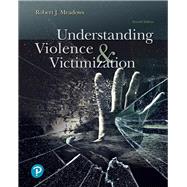Understanding Violence and Victimization
, by Meadows, Robert J.- ISBN: 9780134868257 | 0134868250
- Cover: Paperback
- Copyright: 1/3/2018
For courses in victimology and criminal justice.
Combining theory with responses to victimization
Understanding Violence and Victimization explores the various forms of violence and their profound impact on victims across settings — at home, in the community, or as a result of personal assault or abuse. Drawing on extensive field experience, Meadows provides theory and recommendations, and contextualizes the diverse influences on violence and victimization — from social and legal responses, to the offender’s role. More practical than theoretical, the 7th edition features updates across all chapters reflecting current issues and developments in the field. It includes a new chapter on firearms and victimization, and new analysis and resources covering victim laws and rights.
Robert J. Meadows is professor of criminology and criminal justice at California Lutheran University (CLU), where he also served as department chair for over 10 years. Dr. Meadows received a PhD in criminal justice from Claremont Graduate University and a doctorate of education (EdD) and master’s degree (MS) from Pepperdine University. He received his bachelor’s degree (BS) from Northern Arizona University. Dr. Meadows has over 35 years of teaching, research, and practical experience. Prior to teaching, Dr. Meadows worked as a police officer in Los Angeles (LAPD) assigned to patrol, accident investigation, and recruit training. Prior to CLU, he taught at Kent State University, Ohio; Appalachian State University North Carolina; and Glendale College, Glendale, California. Dr. Meadow’s research and teaching interests include violence and victimization, legal issues in criminal justice, and comparative justice systems. He has authored a number of articles and two books: Evil Minds (Pearson-Prentice Hall, 2005) and the 7th edition of Understanding Violence and Victimization.
CHAPTER 1: MEASURING AND UNDERSTANDING VIOLENCE
Learning Objectives
Introduction
The Fear of Violent Crime
Crime Data
Influences of Violence
Summary
Key Terms and Concepts
Discussion Questions and Learning Activities
Web Sources
Recommended Readings
References
CHAPTER 2: VICTIMIZATION THEORY
Learning Objectives
Introduction
Impact of Victimization
Modern Victimization Theories
New Technology
Summary
Key Terms and Concepts
Discussion Questions and Learning Activities
Web Sources
Recommended Readings
References
CHAPTER 3: VICTIMS OF FAMILIAL VIOLENCE
Learning Objectives
Introduction
The Stalking Problem
Intimate Partner Violence
The Law and Domestic Violence
Elder Abuse and Neglect
Child Abuse and Neglect
Victims of Rape and Sexual Violence
Summary
Key Terms and Concepts
Discussion Questions and Learning Activities
Web Sources
Recommended Readings
References
CHAPTER 4: NONFAMILIAL VIOLENCE AND VICTIMIZATION
Learning Objectives
Introduction
Robbery
Murders and Assaults by Strangers
Bias and Hate-Motivated Crimes
Terrorism
Summary
Key Terms and Concepts
Discussion Questions and Learning Activities
Web Sources
Recommended Readings
References
CHAPTER 5: INSTITUTIONAL AND WORKPLACE VIOLENCE
Learning Objectives
Introduction
Overview of Institutional and Workplace Violence
Institutional Homicides
Categorization of Institutional and Workplace Violence
Sources of Workplace Violence
Warning Signs of Violence
Bullying in the Workplace
Employer Liability for Institutional Victimization
Sexual Harassment and Legal Liability
Reducing the Violence Threat: the Targeted Human Resource
Approach
Summary
Key Terms and Concepts
Discussion Questions and Learning Activities
Web Sources
Recommended Readings
References
CHAPTER 6: SCHOOL VIOLENCE AND VICTIMIZATION
Learning Objectives
Introduction
Research on School Crime and Violence
Teachers At Risk
Explaining School Violence
Early Warning Signs of Violent Behavior
Responding to School Violence
Zero Tolerance
Summary
Key Terms and Concepts
Discussion Questions and Learning Activities
Web Sources
Recommended Readings
References
CHAPTER 7: CRIMINAL JUSTICE AND INJUSTICE
Learning Objectives
Introduction
Sources of Injustice
Is the Justice System Broken?
The Police
Prosecution and the Judicial Process
Crime Legislation, Sentencing, and Injustice
Three Strikes Law and Mandatory Minimums
Enforcing Laws: Sanctuary Cities Crime and Illegal Immigration
Felony Murder Rule
Sex Registration Laws
Corrections
Prison Victimization
Summary
Key Terms and Concepts
Discussion Questions and Learning Activities
Web Sources
Recommended Readings
References
CHAPTER 8: HUMAN TRAFFICKING AND VICTIMIZATION
Learning Objectives
Introduction
Scope of Human Trafficking
Victims of Sex Trafficking
The Refugee Crisis and Trafficking
Sex Trafficking in the United States
Other Consequences of Sex Trafficking Victims
Labor Trafficking
Bonded Labor
Debt Bondage Among Migrant Laborers
Involuntary Domestic Servitude
Forced Child Labor
Child Soldiers
Laws Prohibiting Human Trafficking
Responding to Human Trafficking
T Nonimmigrant Status (T Visa)
U Nonimmigrant Status (U Visa)
Summary
Key Terms and Concepts
Discussion Questions and Learning Activities
Web Sources
Recommended Readings
References
CHAPTER 9: FIREARMS AND VICTIMIZATION
Learning Objectives
Introduction
Gun Laws
Summary
Notes
Key Terms and Concepts
Discussion Questions and Learning
Activities
Web Sources
Recommended Readings
References
CHAPTER 10: RESPONDING TO CRIMINAL VICTIMIZATION
Learning Objectives
Introduction
Proactive Responses
Reactive Responses to Victimization
Sexual Offender Notification Laws
Victim Advocacy Groups
Civil Justice for Victims
Summary
Key Terms and Concepts
Discussion Questions and Learning Activities
Web Sources
Recommended Readings
References
Appendix A: Major Sources of Victimization Data and Information
Appendix B: Resource Guide
Appendix C: Victimization Checklist
The New copy of this book will include any supplemental materials advertised. Please check the title of the book to determine if it should include any access cards, study guides, lab manuals, CDs, etc.
The Used, Rental and eBook copies of this book are not guaranteed to include any supplemental materials. Typically, only the book itself is included. This is true even if the title states it includes any access cards, study guides, lab manuals, CDs, etc.
Digital License
You are licensing a digital product for a set duration. Durations are set forth in the product description, with "Lifetime" typically meaning five (5) years of online access and permanent download to a supported device. All licenses are non-transferable.
More details can be found here.






